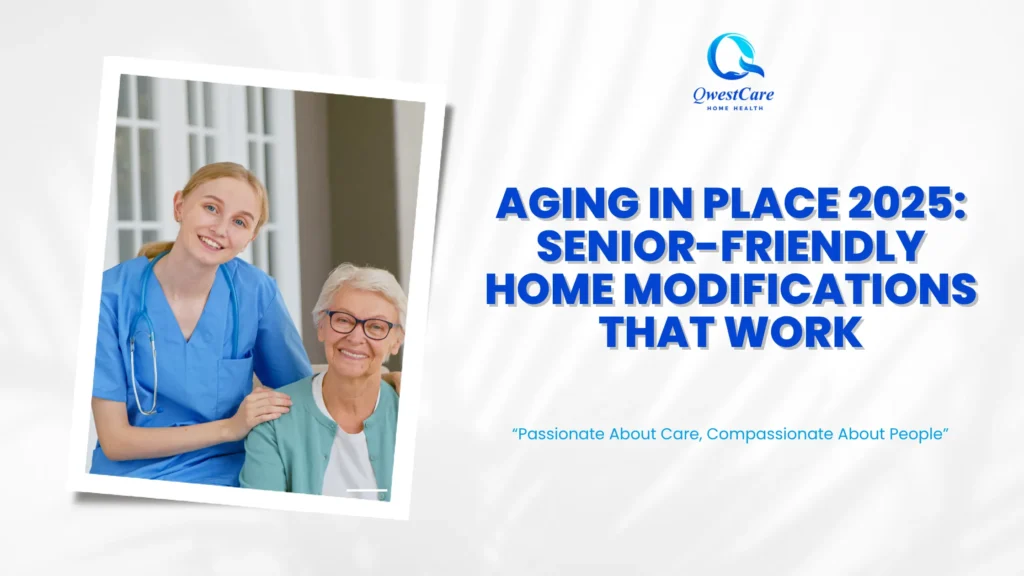Growing older doesn’t mean leaving the place you call home. More seniors are choosing to stay right where they are—at home. It’s called “aging in place,” and it’s all about living safely, comfortably, and independently. With the right changes, any home can become senior-friendly. From bathroom grab bars to tech tools for managing medications, even small updates can make a big difference.
What Is Aging in Place?
Aging in place means staying in your home as you get older instead of moving into assisted living. It’s about keeping your freedom while staying safe. This works best when your home supports your needs, both now and in the future.
Homes not built with seniors in mind can become risky. Stairs, poor lighting, or narrow doorways can be a problem. That’s where home modifications come in.
When the home fits your needs, life becomes easier and more enjoyable.
Why Home Modifications Matter in 2025
By 2025, millions more people over 65 will be living at home. Families, caregivers, and health experts all agree: the home must adjust to the person, not the other way around.
What makes 2025 different?
- More smart home tech is available.
- Caregiving services can now be added to daily life at home.
- People are living longer, often with chronic conditions.
- Home designs are now easier and cheaper to change.
Aging in place is not just a trend—it’s becoming the norm. And planning early is the smartest move.
Essential Rooms to Focus On
Not every room needs a full makeover. Focus on the ones used most often.
Safer Bathrooms
Bathrooms are common places for falls. To make them safer:
- Install grab bars near the toilet and in the shower
- Use a walk-in tub or zero-entry shower
- Place non-slip mats inside and outside the shower
- Add a shower chair and a hand-held showerhead
- Raise the toilet seat for easier use
These changes help seniors move around with less risk.
Accessible Kitchens
A safe kitchen is key for cooking, eating, and daily routines.
- Lower the countertops or make them adjustable
- Use pull-out shelves and easy-open drawers
- Choose appliances with large buttons and an auto shut-off
- Install a hands-free faucet
Also, keep everyday items within easy reach—no need to stretch or bend.
Safer Bedrooms and Living Areas
These spaces need to feel calm and safe.
- Remove throw rugs or use non-slip versions
- Add bed rails or lower the bed height
- Use furniture with firm cushions and arms
- Clear, wide walking paths
- Place light switches at both ends of the room
Comfort is just as important as safety. These updates can help seniors move freely and rest well.
Smart Tech and Safety Gadgets for Seniors
Technology now plays a huge role in helping people age in place. It’s not just about luxury—it’s about safety, health, and peace of mind.
Fall Detection and Emergency Alerts
Falls are a top reason seniors end up in the hospital. Devices can now detect a fall and send help right away.
Options include
- Medical alert bracelets or pendants
- Smartwatches with fall sensors
- Bed and floor alarms
These tools alert family or caregivers fast—sometimes even without pressing a button.
Lighting and Smart Controls
Good lighting prevents accidents. Smart lights turn on automatically when someone enters a room or wakes at night.
Also try:
- Voice-controlled lights and thermostats
- Smart plugs that turn off devices on a timer
- Video doorbells and cameras for extra safety
Easy controls mean more freedom and fewer hazards.
Devices for Managing Medications
Managing medications gets harder with age. Seniors may take multiple pills at different times. Missing doses or taking too much can be risky.
Here’s how tech helps:
- Pill dispensers that lock until it’s time to take them
- Apps that send reminders on phones or tablets
- Voice alerts from smart speakers
- Automatic refills ordered through pharmacies
These tools lower the chance of missed meds or mistakes. Some even notify caregivers if a dose is skipped.
Caregivers and senior companion care providers can also help organize, remind, and double-check meds.
Cost-Effective Modifications That Make a Big Difference
You don’t have to remodel the whole house. Even small upgrades can help:
- Install handrails on both sides of the stairs
- Add lever-style door handles
- Use brighter lightbulbs throughout the home
- Replace door thresholds with smooth floor transitions
- Place seating at every entrance or hallway
Many of these fixes cost less than $100 and can be done in a day. Some communities offer help or grants for seniors to pay for home modifications.
Role of Family, Caregivers, and Community Programs
Aging in place works better with a team. Family members, neighbors, caregivers, and local services can all help.
Here’s what they can do:
- Check the home for safety risks
- Help with shopping, cleaning, and meal prep
- Set up tech tools or apps
- Offer rides or connect with home care services
- Help with managing medications and doctor visits
Community programs also offer:
- Home visits
- Free safety checks
- Fall prevention classes
- Group activities to reduce loneliness
Look for senior centers, local health departments, or nonprofit programs nearby.
Tips for Planning and Avoiding Stress
Don’t wait for a fall or hospital stay to make changes. Planning keeps life smooth and avoids panic later.
Here’s how to get started:
- Walk through each room and look for risks
- Talk to your doctor or care team
- Ask a professional for a home safety review
- Make a list of must-do changes vs. nice-to-have
- Set a timeline and budget
Start with easy fixes. Then move to bigger updates. It’s okay to take it step by step.
Final Thoughts
Aging in place lets seniors live with dignity, comfort, and freedom. But it takes planning. From better lighting to smart tools for managing medications, every change counts.
The goal is simple: make the home safe and easy to live in. That way, seniors can enjoy the life they’ve built right in their own space.
FAQs
What are the most important changes for aging in place?
Focus on safety first—grab bars in the bathroom, non-slip floors, good lighting, and tools for managing medications. These reduce fall risks and daily struggles.
How can technology help seniors live at home?
Tech helps with reminders, fall alerts, lighting, and voice control. It also supports managing medications, staying connected, and feeling secure.
How do you keep track of medications safely at home?
Use pill organizers, reminders, smart dispensers, or caregiver help. Always double-check dosages and store meds safely away from heat and moisture.
Are home modifications expensive?
Not always. Some fixes are cheap, like grab bars or brighter lights. Bigger changes cost more, but grants or community help may lower the cost.
Who can help with home changes for seniors?
Family, sen ior companion care teams, contractors, or community health programs can assist with safety checks, planning, and installation.



